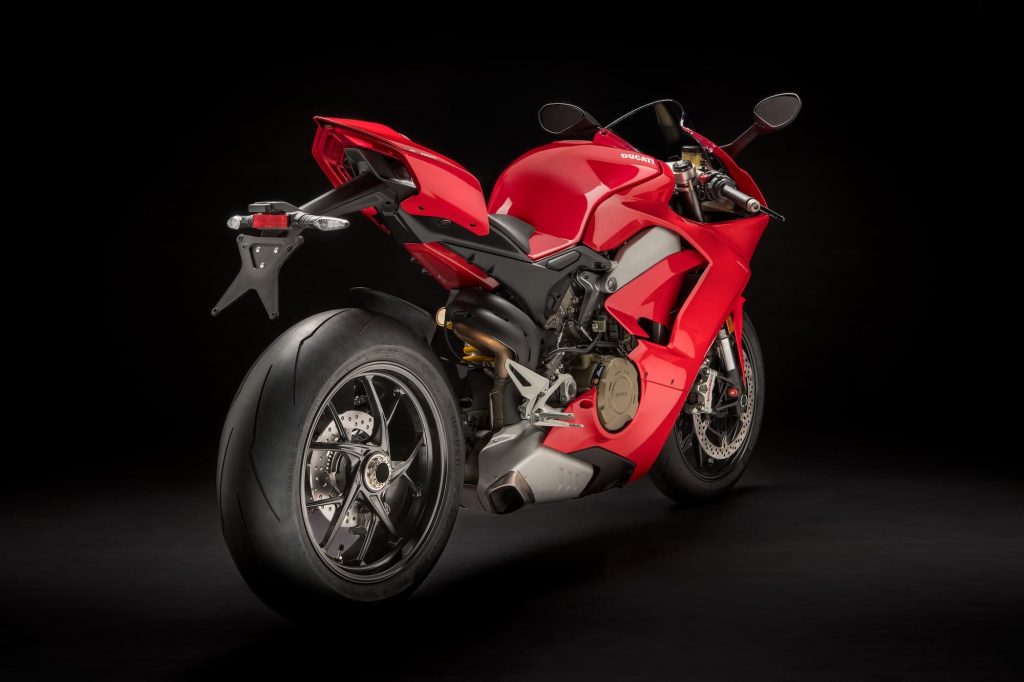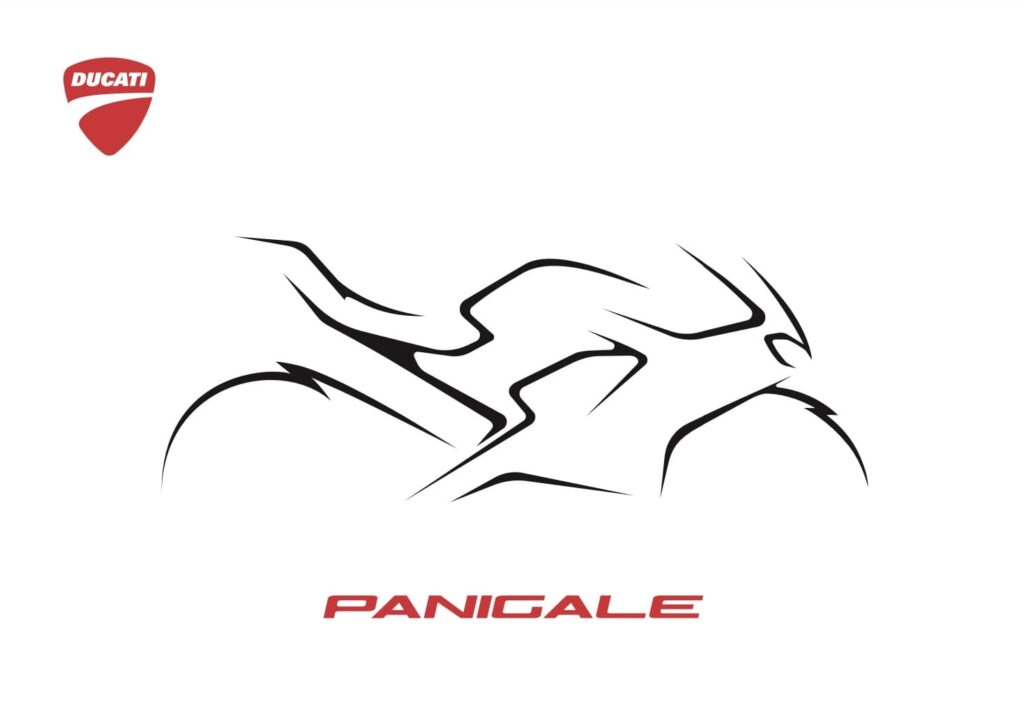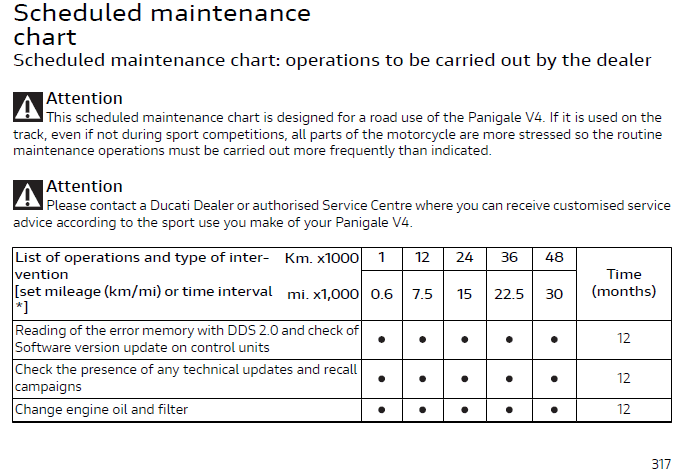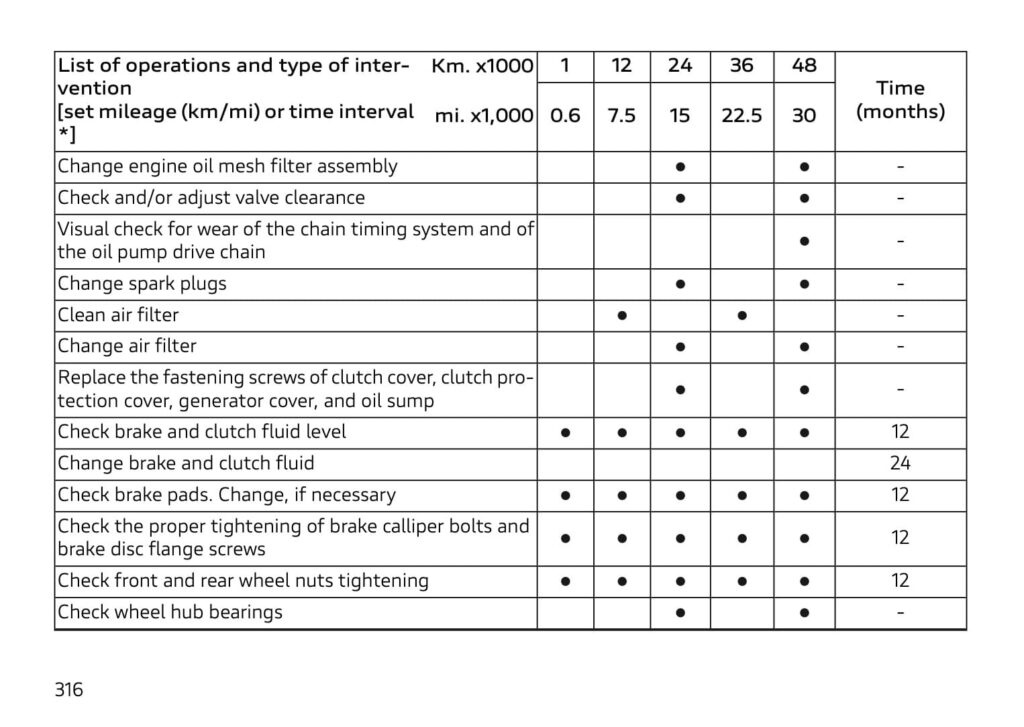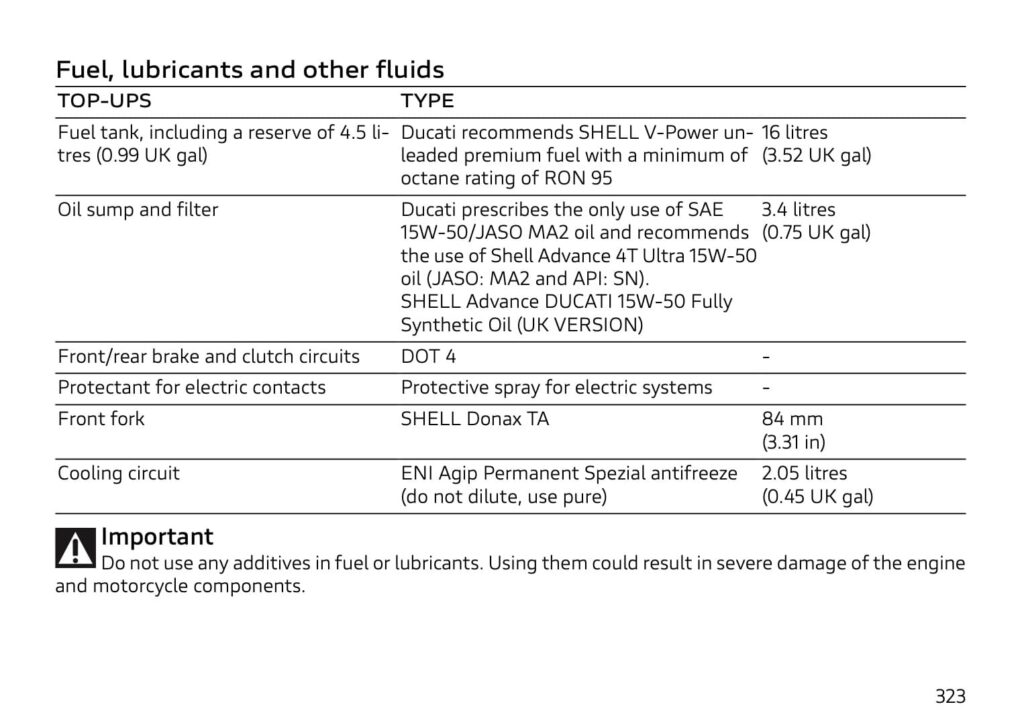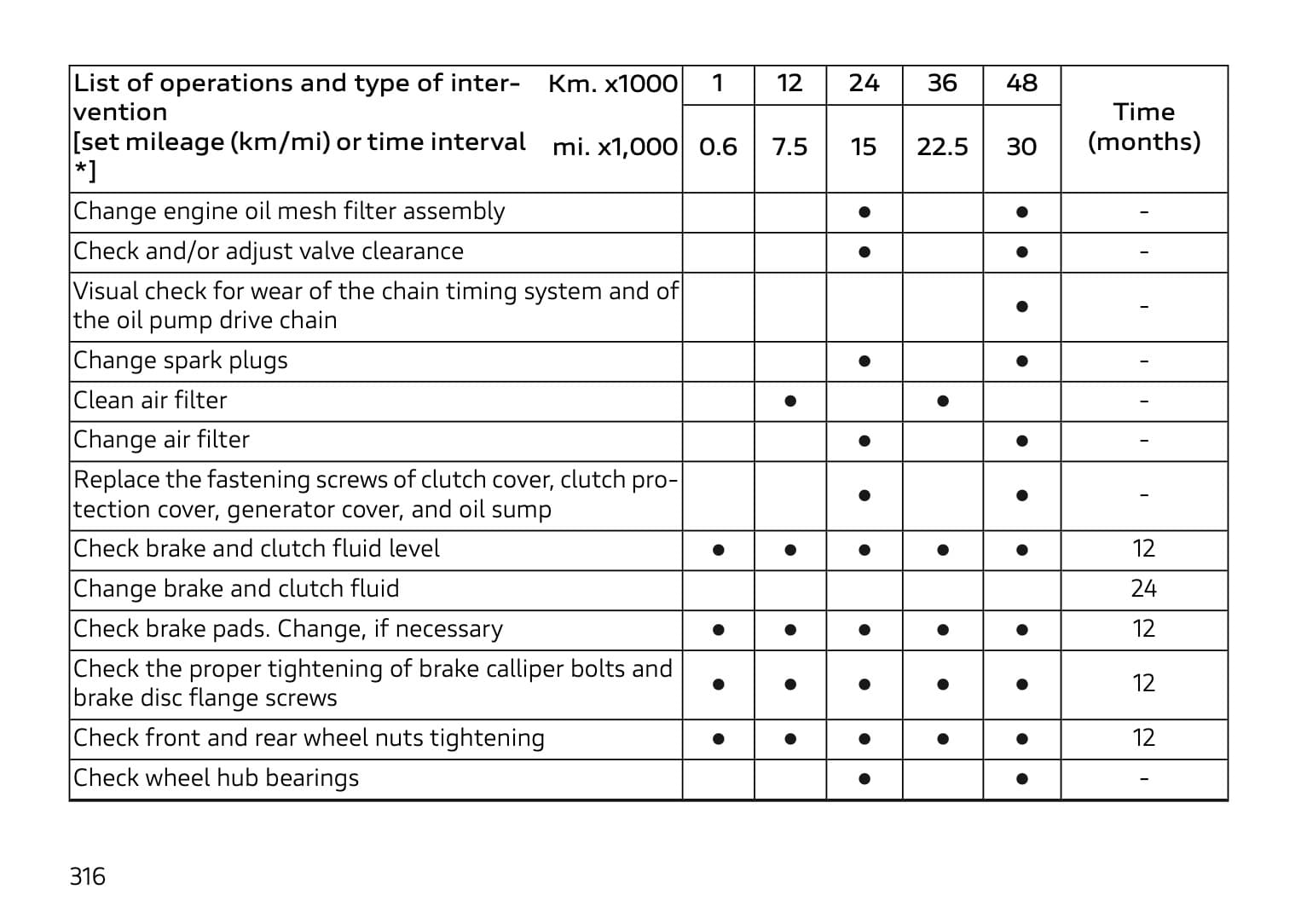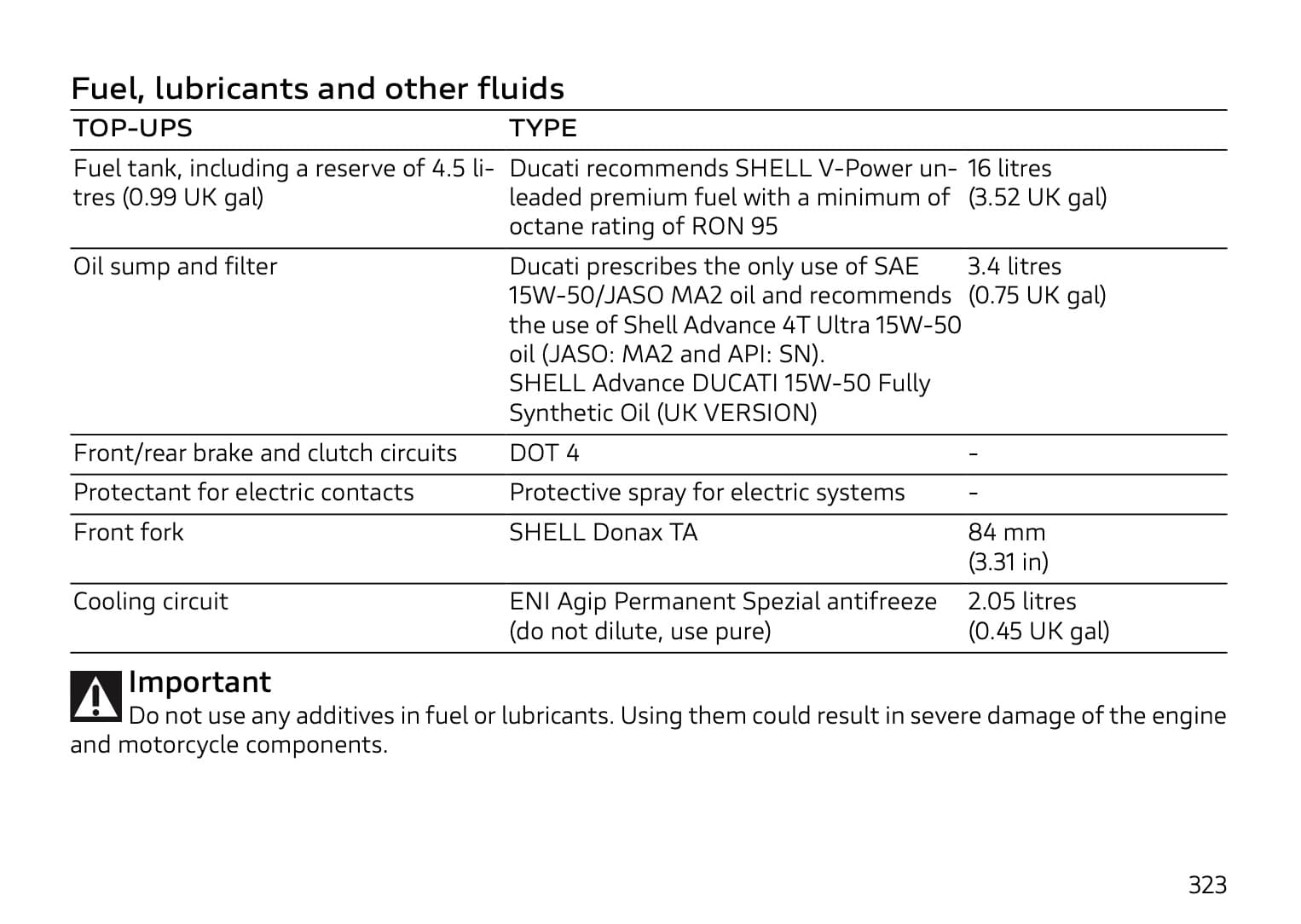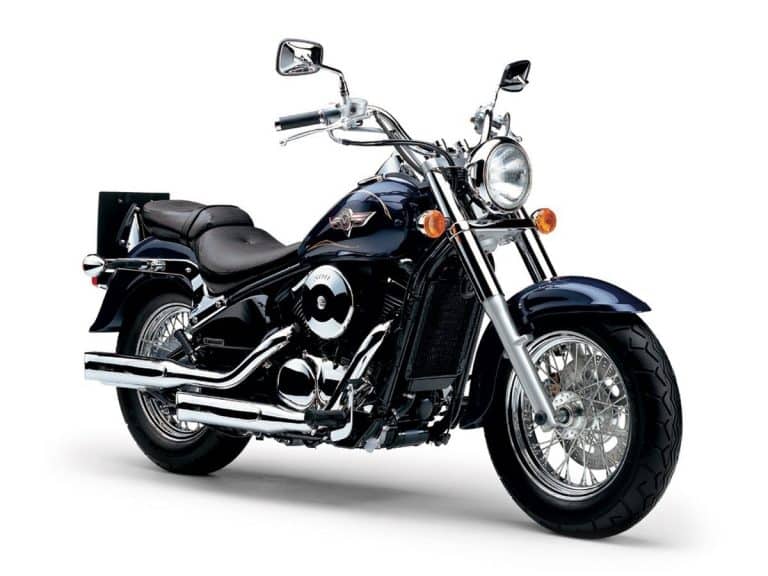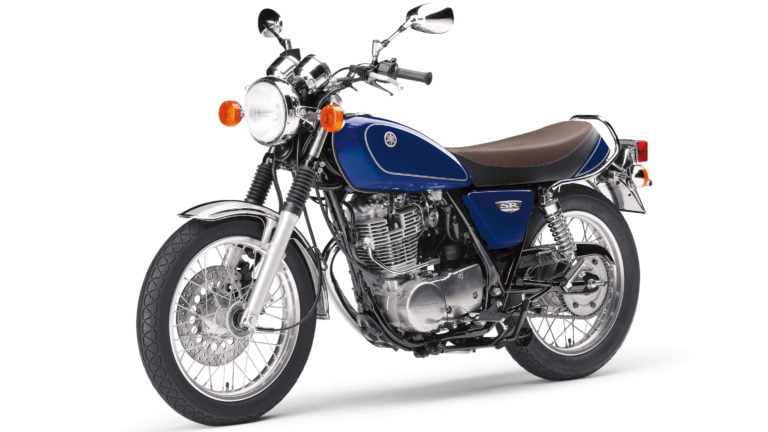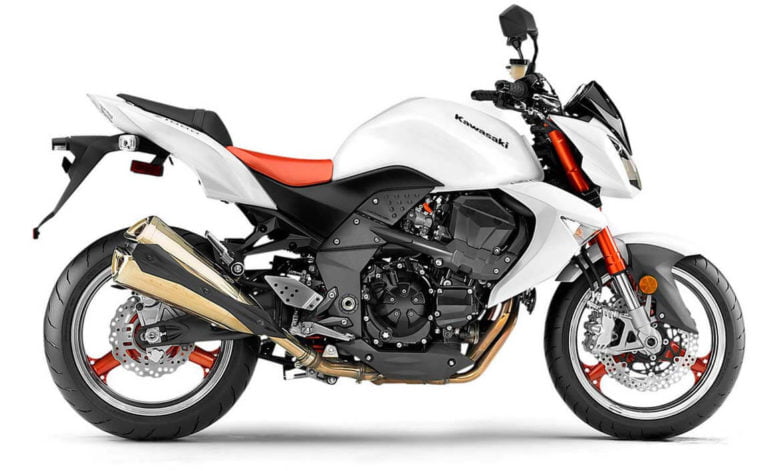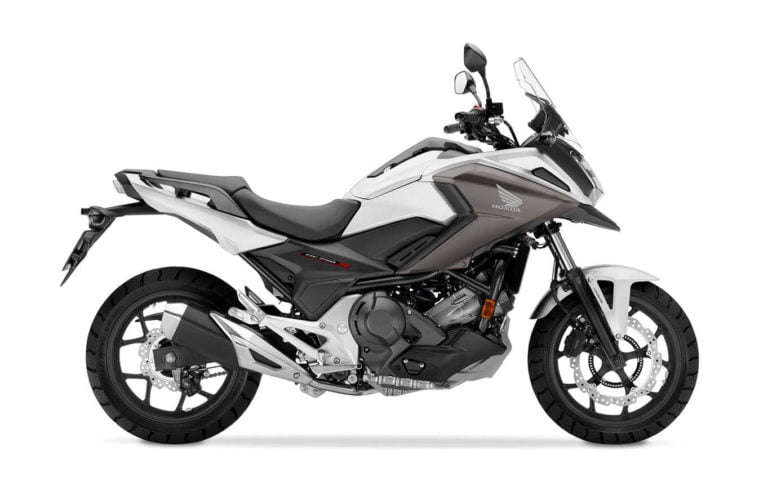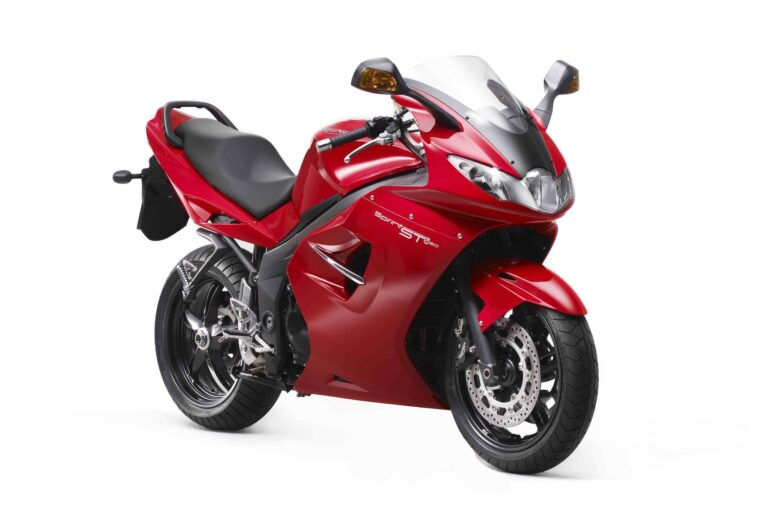Ducati Panigale V4 (2018+, base model) Maintenance Schedule
This is the Ducati Panigale V4 maintenance schedule and service intervals — sourced from the owner’s manual, also referencing parts diagrams.
So you’re going to service your own Ducati Panigale V4 Superbike are you? Brave soul! Here’s the full maintenance schedule for the Ducati Panigale V4 (base model).
Here are all the Ducati Panigale V4 models:
- Ducati Panigale V4 (base model)
- Ducati Panigale V4 S (including Corse, Speciale) — active Öhlins suspension, Marchesini wheels
- Ducati Panigale V4 R (998cc) — smaller engine, lighter components
- Ducati Panigale V4 SP — race spec but with the 1103cc engine
The Ducati Panigale V4 succeeded the already successful Ducati 1299 Panigale.
The Ducati Panigale V4 line is all based around the Desmosedici Stradale V4 engine, which is Ducati’s name for their four-valve-per-cylinder V4 engine. Apart from the short run in 2007-08 of the Ducati Desmosedici RR, this is the first time Ducati has had a V4 engine in a road-going motorcycle.
Another maintenance-specific fact is that the Panigale V4 has a self-bleeding clutch. One less maintenance task for you!
This site has links for things like oil and spark plugs from which we earn a commission (which unfortunately nobody can save, not even us). If you appreciate this work, then please use those links. Thanks!
Ducati Panigale V4 Service Intervals
Overall, the Ducati Panigale V4’s Desmosedici Stradale motor has service intervals of 7500 miles or 12000 km.
Every service, change the oil and filter, and do a comprehensive check of the motorcycle.
The Panigale V4’s valve inspection service interval is 24000 km or 15000 miles. Not as generous as the most wide intervals in the twin motors, but not bad. But as the Panigale V4 has a Desmosedici Stradale engine, there are 16 valves, each with both an opening and closing cam… so 32 measurements and potential adjustments to make.
Since the Panigale has a hydraulic clutch and brake, you may find it convenient to change brake and clutch fluid at the same time on both.
Further, as the Panigale V4 has a liquid-cooled motor, the coolant needs to be replaced periodically.
One interesting additional part to regular maintenance for the Panigale V4 is replacing the fork fluid, which Ducati recommends every 3 years.
Finally, keep the chain clean and lubricated.
What you need to service your Ducati Panigale V4
Ducati specifies fluids that aren’t easy to get online. Even dealers often give substitutes. But here’s what they recommend, plus some alternative suggestions.
| Part | Ducati Panigale V4 spec |
|---|---|
| Engine oil | Ducati recommends “Shell Advance DUCATI 15W-50 Fully Synthetic Oil”, or another oil that is the 15W-50, meets API standard SN, and/or JASO standard MA2. Some alternatives are * Mobil 1 15W-50 Full Synthetic * Motul 300V 15W-50 — a commonly mentioned favourite for the V4 |
| Oil filter | The V4 engine uses the same oil filter as many other high-end Ducatis, and you can use a HifloFiltro HF159 as an easy-to-obtain replacement. |
| Spark plugs | Standard spark plugs are NGK LMDR10A-JS (easiest to get from a dealer). |
| Air filter | Ducati part number for the air filter is 42610671A. A popular replacement is the Sprint Air Filter for the Panigale V4/S/R with part number P08F1-85. |
| Brake fluid/ Clutch fluid | Ducati specifies using DOT 4, so use something high quality like Castrol DOT 4 full synthetic. |
| Front brake | Part # for the front brake pad set is 61341271A. You can also use EBC HH brake pads FA447HH. |
| Rear brake | Part # for the rear brake pad set is 61340381A. You can also use EBC HH brake pads FA266HH. |
| Chain management | Ducati doesn’t specify a chain lube, so use something well-liked like Motul chain paste, or maybe clean it with a Motul chain care kit. |
| Coolant | The manual recommends ENI Agip Permanent Spezial antifreeze, or an equivalent. If you track the bike, many prefer Redline Water Wetter and distilled water. |
| Battery | Dead battery? If it hasn’t happened, it will happen. The replacement you need is a Yuasa YT7B-BS (12V – 6.5Ah 10HR) (common to many Ducati motorcycles) |
Regular maintenance for the Ducati Panigale V4
This is maintenance that you can do yourself (though the manual says you need a dealer to do it).
Note that Ducati says that “using the motorcycle under extreme conditions, such as very damp and muddy roads or dusty and dry environment, could cause above-average wear of components like the drive system, the brakes or the air filter.” One usually does not take their Panigale down dusty roads, but still, since it can lead to engine damage, attend to these items more often.
Every 1000 km/500 miles OR 6 months (whichever comes earlier), perform the following maintenance:
| Panigale V4 — Regular maintenance |
|---|
| Check engine oil level (Motul 300V 15W-50) |
| Check brake fluid level (Castrol DOT 4) |
| Check tyre pressure and wear |
| Check the drive chain tension and lubrication (Motul chain paste) |
| Check brake pads and replace if necessary (FA447HH, FA266HH) |
Ducati Panigale V4 Maintenance Schedule Table
The following is the list of maintenance operations and to be done on this motorcycle with a distance or time interval — whichever comes earlier.
This maintenance schedule is in the same format as in the manual, though altered to fit this screen.
This scheduled maintenance chart is designed for a road use of the Panigale V4. If it is used on the track, even if not during sport competitions, all parts of the motorcycle are more stressed so the routine maintenance operations must be carried out more frequently than indicated. You can get customised advice from Ducati about how you intend to use your Panigale V4.
A few notes about maintaining a Ducati Panigale V4:
- The cams are chain driven, which means no belts to replace. Hooray!
- As this is a V4 desmosedici motor, there are 16 valves, each with both an opening and closing cam… so 32 measurements and potential adjustments to make.
- Some of the below items can only be done by a Ducati mechanic (marked [D]) as they need Ducati diagnostic equipment or resources
| km x 1000 | 1 | 12 | 24 | 36 | 48 | Time |
|---|---|---|---|---|---|---|
| mi x 1000 | 0.6 | 7.5 | 15 | 22.5 | 30 | (months) |
| Annual maintenance checklist (see below) — Perform | ✓ | ✓ | ✓ | ✓ | ✓ | 12 |
| Change engine oil (Motul 300V 15W-50) | ✓ | ✓ | ✓ | ✓ | ✓ | 12 |
| Change oil filter (HF159) | ✓ | ✓ | ✓ | ✓ | ✓ | 12 |
| Change engine oil mesh filter assembly | ✓ | ✓ | ||||
| Check and/or adjust valve clearances | ✓ | ✓ | ||||
| Visually check for wear of the chain timing system | ✓ | ✓ | ||||
| Visually check the wear of the oil pump drive chain | ✓ | |||||
| Change spark plugs (LMDR10A-JS) | ✓ | ✓ | ||||
| Clean air filter | ✓ | ✓ | 12 | |||
| Change air filter (P08F1-85) | ✓ | ✓ | ||||
| Change brake and clutch fluid (Castrol DOT 4) | 24 | |||||
| Check and lubricate the rear wheel shaft | ✓ | ✓ | 24 | |||
| Check steering bearings and lubricate, if necessary | ✓ | ✓ | ||||
| Change front fork fluid (Shell Donax TA) | 36 | |||||
| Change coolant (ENI Agip Spezial) | ✓ | 48 | ||||
| Replace the fastening screws of clutch cover, clutch protection cover, generator cover, and oil sump | ✓ | ✓ | ||||
| Check front and rear wheel hub bearings | ✓ | ✓ | ||||
| Check the cush drive damper on rear sprocket | ✓ | ✓ | ||||
| Visually check the fuel lines | ✓ | ✓ | ||||
| Check secondary air system operation | ✓ | ✓ | ||||
| [D] Reset the variable-length intake manifold system (VIS) using DDS 2.0 | ✓ | ✓ | ||||
| [D] Adjust the Bowden cable of the exhaust valve opening through the DDS 2.0 | ✓ | ✓ | ✓ | ✓ | ✓ |
Annual maintenance checklist
Below is the annual maintenance checklist for the Ducati Panigale V4. Perform it according to the schedule above.
| Ducati Panigale V4 annual maintenance checklist |
|---|
| [D] Read the error memory with DDS 2.0 and check software version update on control units |
| [D] Check the presence of any technical updates and recall campaigns |
| Check brake and clutch fluid level Fluid level drops with wear of the brake and clutch. Top up with Castrol DOT 4 or similar |
| Check brake pads. Change if necessary |
| Check the proper tightening of brake calliper bolts and brake disk flange screws |
| Check front and rear wheel nuts tightening Front: 63 Nm / 46 lb-ft Rear axle (sprocket side): 230 Nm / 170 lb-ft |
| Check the proper tightening of final drive front and rear sprocket nuts Front sprocket: 55 Nm / 41 lb-ft Rear sprocket: 44 Nm / 32 lb-ft |
| Check final drive chain tension and lubrication (Motul chain care kit) |
| Check final drive chain sliders for wear |
| Visually check the front fork and rear shock absorber seals |
| Check for proper tightening of the frame-to-engine fasteners and swinging arm Front frame to engine fastener: 90 Nm / 66 lb-ft Rear suspension upper to lower mount to engine fastener: 35 Nm / 26 lb-ft Rear lower suspension support to engine fastener: 35 Nm / 26 lb-ft |
| Check the freedom of movement and tightening of the side stand |
| Check rubbing points, clearance, freedom of movement and positioning of hoses and electric wiring in view |
| Lubricate the levers at the handlebar and pedal controls (Lithium soap-based grease) |
| Visually check the coolant level and sealing of the circuit |
| Check electric fan operation |
| Check tyre pressure and wear (See below for standard tire pressures) |
| Check idling |
| Check the battery charge level |
| Check the operation of all electric safety devices (side stand sensor, front and rear brake switches, engine kill switch, gear/neutral sensor) |
| Check lighting devices, turn indicators, horn and controls operation |
| [D] Reset the Service indication through the DDS 2.0 |
| Final test and road test the motorcycle, testing safety devices (e.g. ABS and DTC) |
| Softly clean the motorcycle |
| [D] Fill out that the service was performed in on-board documentation (Service Booklet) |
Ducati Panigale V4 Chain Maintenance
Ducati recommends cleaning and lubricating the chain regularly — every 1000 km / 600 miles or 6 months, or earlier if you ride in adverse conditions. Ducati recommends Shell Advance chain lubricant, but you can use any high-spec chain lube, like Motul chain lubricant for example.
Ducati recommends checking the chain tension / clearance as part of the standard annual service. too. This is how you do so.

To check the chain slack, measure the distance between the chain and the sliding guard.
- Put the motorcycle on its side stand.
- Push the finger down with a finger and release it.
- Measure the distance between the centre of the chain pins and the chain sliding guard.
Target chain slack for the Ducati Panigale V4: 23-25 mm (0.9-1.0 inches)
If the chain slack is out of spec, you need to release the two pinch bolts at the rear on the eccentric hub, use an eccentric wrench to adjust the slack, and then tighten the pinch bolts again. (20 Nm / 14 lb-ft).
Tyre sizes and pressures for the Ducati Panigale V4
The manual says that the Panigale V4 arrives shod with Pirelli Diablo Supercorsa SP “tubeless” tyres.
Here are the tire sizes and recommended pressures.
| Wheel | Tyre size | Tyre pressure (cold) |
|---|---|---|
| Front | 120/70-ZR17 | Road: 2.3 bar (33.36 psi) Track: 2.3 bar (33.36 psi) |
| Rear | 200/60-ZR17 | Road: 2.1 bar (30.46 psi) Track: 1.8 bar (26.10 psi) |
The manual also has suggested tyre pressures for if you have a pillion. But that isn’t a common use case. I’d suggest you find your own ideal pressure in that (somewhat unusual and thus very variable) situation.
About the Ducati Panigale V4
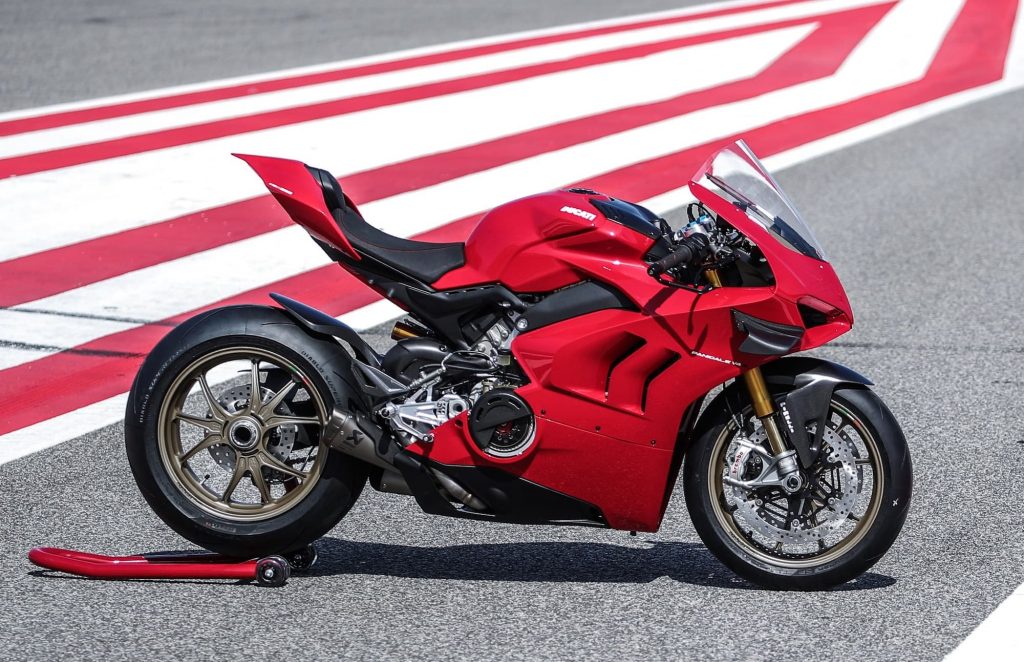
The Panigale V4 is the latest in a series of Panigale-branded superbikes that started with the Ducati 1199 Panigale. Even though the V4 engine layout is new, Ducati kept the Panigale name.
The Ducati Panigale V4 was a huge departure from Ducati, who had made their brand for decades on L twins (which is a V-twin but with a 90 degrees, and canted forward).
Ducati launched the Panigale V4 and V4 S in 2018 — and the motorcycling world has loved it.
The Panigale V4 is powered by a 1103cc 90-degree V4 engine with 4 desmodromically actuated valves per cylinder. The compression ratio is 14.0:1. The engine is liquid-cooled, fuel-injected, and run by full ride-by-wire.
The power output of the V4 and V4 S engine is monstrous — 157.5 kW (214 hp) at 13,000 rpm, and 124 Nm (91.5 lb-ft) @ 10,000 rpm. No wonder the Ducati has so many rider aids to make sure you don’t loop the thing — it’s powered by the latest generation of the Bosch 6-axis IMU giving traction control and ABS, all with lean angle as an input.
There are many other rider aids/safety features too, like wheelie control, slide control, riding modes, brake control, and automatic tyre calibration.
Ducati has released a number of motorcycles to date under the Panigale V4 moniker.
Here’s how the specs of the Ducati Panigale V4 models compare in a nutshell:
| Model | Panigale V4 | Panigale V4 S, Speciale (Tricolore), Corse | Panigale V4 R | Panigale V4 SP |
|---|---|---|---|---|
| Engine capacity | 1103cc Desmosedici Stradale V4 | 1103cc Desmosedici Stradale V4 | 998cc Desmosedici Stradale V4 | 1103cc Desmosedici Stradale V4 |
| Peak power | 157.5 kW (214hp) @ 13000 rpm | 157.5 kW (214hp) @ 13000 rpm | 162 kW (221 hp) @ 15250rpm; 174 kW (234 hp) @ 1550 rpm with racing exhaust | 157.5 kW (214hp) @ 13000 rpm |
| Peak torque | 124 Nm (92 ft-lb) @ 1000 rpm | 124 Nm (92 ft-lb) @ 1000 rpm | 112 Nm (83 lb-ft) @ 11,500 rpm – 119 Nm (88lb-ft) @ 11,750 rpm with full-racing exhaust | 124 Nm (92 ft-lb) @ 1000 rpm |
| Clutch | Wet | Wet | Dry | Dry |
| Compression ratio | 14.0:1 | 14.0:1 | 14.0:1 | 14.0:1 |
| Front suspension | Fully adjustable 43mm chromed steel USD Showa BPF fork | Fully adjustable 43mm TiN treated USD NIX30 Öhlins fork, electronic compression/rebound adjustment | Fully adjustable Ø 43 mm Öhlins NPX25/30 pressurized fork with TiN treatment | Fully adjustable 43mm TiN treated USD NIX30 Öhlins fork, electronic compression/rebound adjustment |
| Rear suspension | Fully adjustable Sachs rear shock | Fully adjustable Öhlins TTX36 damper, electronic compression and rebound damping adjustment | Fully adjustable Öhlins TTX36 unit. Aluminium single-sided swingarm. | Fully adjustable Öhlins TTX36 unit. Aluminium single-sided swingarm. |
| Front braking | 2 x 330mm semi-floating discs, Brembo Stylema (M4.30) 4-piston calipers | 2 x 330mm semi-floating discs, Brembo Stylema (M4.30) 4-piston calipers | 2 x 330mm semi-floating discs, Brembo Stylema (M4.30) 4-piston calipers | 2 x 330mm semi-floating discs, Brembo Stylema R calipers, Self-bleeding Brembo MCS19.21 master cylinder with “remote adjuster” |
| Steering damper | Adjustable Sachs | Öhlins, electronically controlled | Öhlins, manually controlled | Öhlins, electronically controlled |
| Wheels | 5-spoke light alloy | 3-spoke Marchesini alloy (“Tri-W”) | 3-spoke Marchesini alloy (“Tri-W” | 5-split spoke carbon fiber (ex-Superleggera) |
| Dry weight | 175 kg (385 lb) | 174 kg (384 lb) | 172 kg (379 lb) | 173 kg (381 lb) |
| Kerb weight (90% fuel) | 198 kg (436 lb) | 195 kg (430 lb) | 193 kg (425 lb) | 194 kg (427 lb) |
So while the Ducati Panigale V4 base model is the “lowest spec”, it still has high-grade fully adjustable suspension, and the same spec brake calipers as every bike up to the Panigale V4 R.
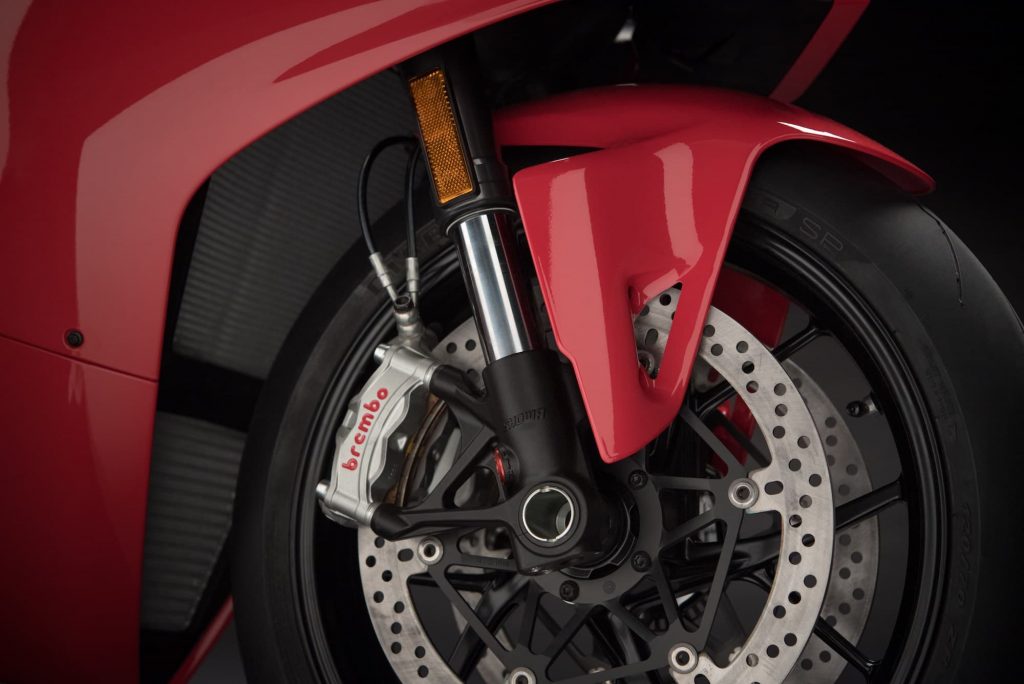
The Panigale V4 also has an incredible number of ride aids, thanks to its Bosch 6-axis IMU. Cornering ABS is just the beginning. The Panigale V4 comes with advanced traction control, slide control, wheelie control, “Ducati Power Launch”, an up/down quickshifter, engine brake control, and electronic suspension.
Ducati has made some incremental updates to the Panigale V4 since its launch, tweaking the electronics and adding features to the computer. These all add up to a bike that’s quicker on track (according to their tests) despite having the same specs all around.
For example, the 2021 Panigale V4 got a new “Riding Mode” strategy that lets the rider compare configurations on the track to figure out the best setup.
Ducati also released a very slightly tamer (well, less extreme) street-oriented bike in 2020 with the Panigale V4’s engine, though in different guise and tune: the Ducati Streetfighter V4 and V4S.
Ducati Panigale V4 Owner’s Manual
The above info was sourced from the owner’s manual for the Ducati Panigale V4. You can download it from the Ducati website here.

